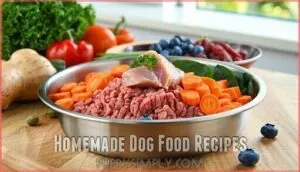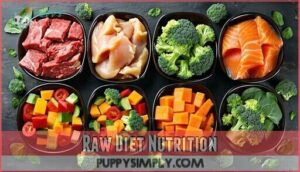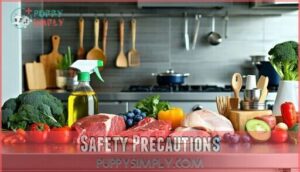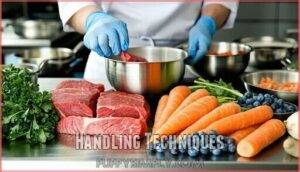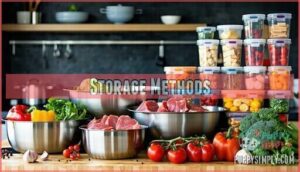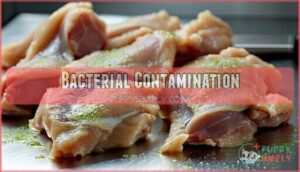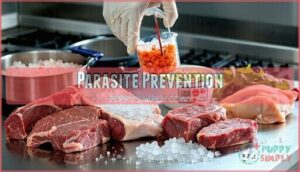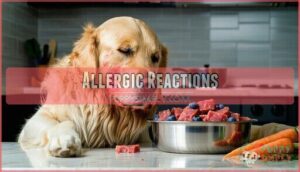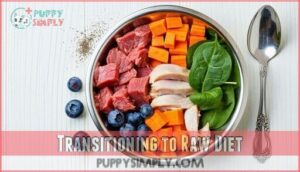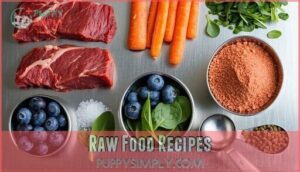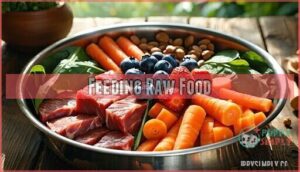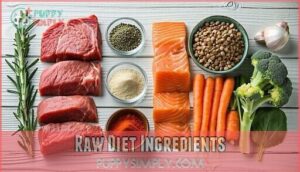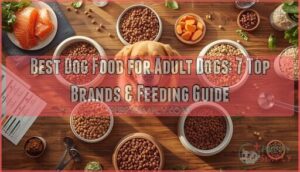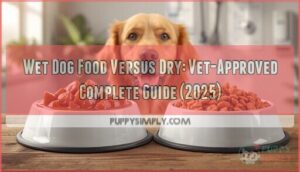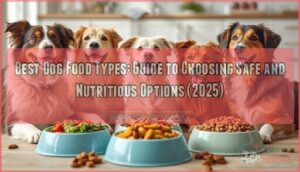This site is supported by our readers. We may earn a commission, at no cost to you, if you purchase through links.
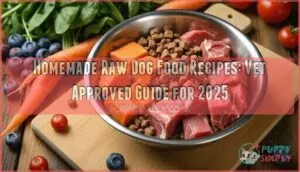 You’re taking control of your dog’s nutrition with homemade raw dog food recipes vet approved by veterinary professionals.
You’re taking control of your dog’s nutrition with homemade raw dog food recipes vet approved by veterinary professionals.
Start with balanced recipes containing 70-80% muscle meat, 10-15% organ meat, and 10-15% raw bones. Essential ingredients include chicken, beef, fish, liver, and vegetables like carrots and spinach.
Always consult your veterinarian before switching, as proper ratios prevent nutritional deficiencies. Handle raw ingredients safely using separate cutting boards and proper refrigeration.
Your dog’s digestive system will thank you for ditching processed kibble. The secret lies in understanding the precise nutritional balance that transforms your kitchen into a canine health sanctuary.
Table Of Contents
- Key Takeaways
- Raw Dog Food Benefits
- Homemade Dog Food Recipes
- Raw Diet Nutrition
- Preparing Raw Dog Food
- Reducing Raw Food Risks
- Transitioning to Raw Diet
- Raw Food Recipes
- Feeding Raw Food
- Raw Diet Ingredients
- Frequently Asked Questions (FAQs)
- How do I make my own raw food for my dog?
- What is a vet approved recipe for homemade dog food?
- What do vets think of homemade dog food?
- Can puppies eat raw dog food safely?
- How much does homemade raw food cost?
- What equipment do I need for preparation?
- Are there any breed-specific raw diet considerations?
- How long does diet transition typically take?
- Conclusion
Key Takeaways
- You’ll need to balance protein ratios carefully – aim for 70-80% muscle meat, 10-15% organ meat, and 10-15% raw bones to prevent nutritional deficiencies in your homemade recipes.
- You must consult your veterinarian before switching – vet-approved formulations ensure your dog receives proper nutrition and help you avoid dangerous imbalances that could harm your pet’s health.
- You’ll see health improvements within weeks – expect better digestion, shinier coats, increased energy levels, and potentially up to 32 months added to your dog’s lifespan with proper raw feeding.
- You need to follow strict safety protocols – use separate cutting boards, freeze meat for 24-48 hours to eliminate parasites, and store prepared meals below 40°F for no more than 3-4 days to prevent bacterial contamination.
Raw Dog Food Benefits
You’ll discover that raw dog food offers significant health benefits when prepared correctly with veterinary guidance.
Studies show raw diets can extend your dog’s lifespan by up to 32 months while improving coat shine, energy levels, and digestive health.
Raw diets boost your dog’s health naturally—adding years to their life while enhancing energy and coat shine.
Improved Health Outcomes
Why settle for commercial kibble when raw dog food offers remarkable health transformations?
You’ll notice dramatic improvements in your dog’s digestion, with smaller, firmer stools and reduced gas.
Your dog’s digestive transformation happens faster than you’d expect with quality raw nutrition.
Raw feeding naturally promotes allergy reduction by eliminating artificial additives and common allergens found in processed foods.
Your pup’s energy levels will soar while maintaining ideal weight management through balanced nutrition and proper portion control.
Increased Lifespan
Your dog’s lifespan can increase by up to 32 months with proper raw diet nutrition.
Longevity factors include diet impact on cellular health, while genetic influence and breed predispositions still play roles. Vet approved recipes support dog health through ideal nutrition.
- Cellular regeneration – Raw dog food provides antioxidants that combat aging
- Immune system strengthening – Fresh ingredients boost natural disease resistance
- Weight management – Proper nutrition prevents obesity-related health issues
- Reduced inflammation – Anti-inflammatory compounds support joint health
- Enhanced nutrient absorption – Natural enzymes improve digestive efficiency
Enhanced Coat Shine
Your dog’s lustrous coat reflects the dietary fats and protein quality you provide through raw feeding.
Omega balance from fish oils and organ meats creates visible shine within weeks.
Hydration levels improve with raw diets, supporting skin health across all breed specifics, making homemade dog food an investment in your pet’s radiant appearance. These vet approved recipes deliver superior nutrition compared to processed alternatives.
Homemade Dog Food Recipes
You’ll find homemade raw dog food recipes offer complete nutritional control while meeting your pet’s specific dietary needs.
These vet-approved formulations combine fresh proteins, essential organs, and carefully balanced nutrients to support peak health and longevity.
Vet Approved Recipes
Finding trusted raw dog food recipes can feel overwhelming, but veterinary-approved formulations take the guesswork out of your prep work.
These recipes undergo rigorous testing for nutritional adequacy and ingredient sourcing, ensuring your dog receives balanced nutrition.
Recipe credibility matters when you’re switching to homemade raw dog food, as veterinary-approved formulations guarantee recipe customization meets your dog’s specific needs.
Vet expertise maintains safety standards for raw diet implementation, and homemade meals can offer long-term health benefits by avoiding harmful additives, providing a foundation for your dog’s overall wellness.
Nutritional Guidelines
Perfect macronutrient ratios keep your dog thriving on homemade raw food.
You’ll need 18-22.5% protein from chicken or beef, 5.5-8.5% healthy fats, and balanced minerals through organ meats.
Maintain calcium-to-phosphorus ratios between 1.2:1 and 1.4:1 for strong bones.
Include vitamin sources like liver for A and D vitamins.
Adjust recipes based on your dog’s weight, activity level, and hydration needs.
Ingredient Selection
Quality ingredients make the difference between a mediocre meal and nutritional excellence for your furry friend. You’ll want to focus on meat variety and organ inclusion while selecting vegetable choices and healthy fats for complete nutrition.
- Premium protein sources – Choose fresh chicken, beef, lamb, or fish as your primary raw dog food ingredients foundation
- Essential organ meats – Include liver, heart, and kidney for vitamins A, D, E, and B complex nutrients
- Colorful vegetables – Add spinach, broccoli, and carrots for fiber, antioxidants, and natural vitamins
- Calcium-rich additions – Incorporate raw bones or calcium sources to maintain proper bone health ratios
Raw Diet Nutrition
Understanding your dog’s nutritional needs is essential when switching to a raw diet.
You’ll need to balance essential nutrients like proteins, fats, vitamins, and minerals to keep your pet healthy and thriving, focusing on complete concepts to ensure a well-rounded diet.
Essential Nutrients
Building balanced raw dog food recipes requires understanding six essential nutrients that fuel your dog’s health.
You’ll need proper protein balance from muscle meat and organs, plus healthy fats including omega-3 fatty acids for nutrient absorption.
Mineral sources like bones provide calcium, while vitamin variety from liver and vegetables guarantees complete nutrition.
These nutritional requirements create truly balanced meals when combined correctly.
A balanced diet is imperative because it guarantees dogs receive essential nutrients for peak body function.
Protein Sources
Your dog’s protein needs start with lean meats like chicken, beef, and lamb as primary sources.
Organ variety including liver, heart, and kidney provides concentrated nutrients that muscle meat can’t match.
Fish options such as salmon and sardines deliver omega-3 fatty acids.
Novel proteins like rabbit offer alternatives for sensitive dogs.
Aim for 18% protein percentage in adult raw dog food recipes following vet approved guidelines.
Healthy Fats
Beyond providing energy for daily activities, healthy fats in raw dog food recipes support critical bodily functions your dog can’t live without.
These vet approved fats boost omega-3 levels, enhance fat digestion, and promote ideal skin health while supporting brain function.
For German Shepherds, a raw diet can also contribute to improved gut health.
- Fish oil and salmon deliver essential omega-3 sources for coat shine and reduced inflammation
- Coconut oil and olive oil provide energy boost while supporting nutrient absorption
- Flaxseed and hemp oils contribute to overall dog nutrition and cellular health
Preparing Raw Dog Food
Preparing raw dog food requires careful attention to safety and proper handling techniques to protect both you and your pet.
You’ll need to follow specific storage methods and sanitation practices to prevent bacterial contamination while creating nutritious meals your dog will love.
Safety Precautions
Your dog’s safety depends on proper precautions when preparing raw food.
Start with fresh ingredients from reputable suppliers to minimize bacterial contamination and zoonotic infections. Always freeze raw meat for 24-48 hours before serving to eliminate parasites using effective freezing techniques.
| Safety Area | Key Precaution |
|---|---|
| Sourcing Ingredients | Buy from certified, reputable suppliers only |
| Bacterial Contamination | Wash hands/surfaces with bleach solution |
| Bone Handling | Choose appropriate size bones, supervise feeding |
| Recipe Balance | Follow veterinarian-approved formulations exactly |
Handling Techniques
Proper handling techniques prevent contamination and keep your dog’s raw meals safe. You’ll need to master these essential skills before preparing any homemade raw dog food.
- Safe Thawing – Defrost frozen portions in the refrigerator overnight, never at room temperature
- Cross-Contamination prevention – Use separate cutting boards and utensils for raw ingredients only
- Bowl Sanitation – Wash feeding bowls with hot, soapy water after each meal
- Freezing Portions – Divide meals into single servings before freezing to avoid refreezing
- Travel Storage – Pack raw food in insulated coolers with ice packs for transportation. Consider using appropriate food storage to maintain freshness.
Storage Methods
Once you’ve mastered safe handling, smart storage keeps your homemade raw dog food fresh and safe.
Store portions in airtight containers to prevent spoilage and contamination. Refrigeration times shouldn’t exceed 3-4 days for raw dog food safety.
Freezing raw ingredients extends shelf life up to two months. Consider using specialized food containers for ideal preservation.
Safe thawing in the refrigerator prevents bacterial growth that compromises dog food storage quality.
Reducing Raw Food Risks
While raw dog food offers significant health benefits, you’ll need to address three main risks to keep your pet safe.
Proper handling techniques and sourcing practices can effectively minimize bacterial contamination, parasite exposure, and allergic reactions.
Bacterial Contamination
Raw meat harbors dangerous bacteria that can sicken both you and your dog. Salmonella and E. coli contamination rates reach 21% in some raw dog food studies. These bacterial risks demand serious attention to raw food safety protocols.
- Source Control – Buy fresh meat from reputable suppliers and check expiration dates carefully
- Freezing Effects – Freeze raw ingredients for 48-72 hours to reduce bacterial load before preparation
- Hygiene Practices – Wash hands thoroughly before and after handling raw dog food ingredients
- Safe Handling – Use separate cutting boards, utensils, and bowls designated only for dog food preparation
- Zoonotic Risks – Store prepared raw dog food safety containers below 40°F and use within 3-4 days
Parasite Prevention
Freezing protocols kill parasites effectively when you freeze raw meat at 0°F for at least 24 hours before feeding.
Sourcing matters – buy from reputable suppliers who test for parasites. Your raw feeding guide should prioritize raw food safety through proper freezing and sourcing practices.
Regular deworming can help prevent common types of worms in your dog. Deworming strategies include regular fecal exams every 6-12 months.
Veterinary consultation helps establish safe handling protocols.
Allergic Reactions
Although your dog might seem perfectly healthy on raw food, allergic reactions can sneak up unexpectedly.
Identifying Allergens becomes essential when switching to homemade dog food, as certain proteins or ingredients may trigger sensitivities.
- Watch for Allergy Symptoms like itchy skin, digestive upset, or ear infections
- Use Elimination Diets to pinpoint specific triggers in raw dog food allergies
- Consider Breed Predisposition since some breeds face higher allergy risks with raw diet for dogs
Transitioning to Raw Diet
When you’re ready to switch your dog to raw food, you’ll need to monitor their health closely and adjust portion sizes based on their response.
Start the conversion gradually over 7-10 days, watching for digestive upset or changes in energy levels while fine-tuning meal amounts to maintain your dog’s ideal weight.
Monitoring Health
Health-tracking becomes your compass when switching to homemade raw dog food.
Monitor key signs daily, including energy levels and appetite changes. Watch for weight fluctuations and behavioral changes that signal adjustment issues.
Examine stool analysis for consistency and color variations. Document any allergy symptoms like itching or digestive upset.
Schedule vet-approved checkups to confirm your canine health monitoring stays on track, and seek immediate veterinary attention if concerning symptoms develop.
Adjusting Portion Sizes
When switching to raw dog food, you’ll need to adjust portion sizes based on your dog’s unique needs.
Activity Levels and Individual Metabolism vary substantially between dogs, making weight monitoring essential during this shift.
Consider these key factors for proper dog food portion control:
- Age Factors – Puppies need more calories per pound than senior dogs
- Breed Differences – Large breeds have different metabolic rates than small breeds
- Activity Levels – Working dogs require more food than couch potatoes
- Weight Monitoring – Weekly weigh-ins help track progress during raw feeding
Start with manufacturer guidelines, then adjust based on your dog’s response.
A raw diet’s nutrient-rich profile supports healthy growth and development.
Veterinary advice guarantees safe homemade dog food transitions.
Raw Food Recipes
You’ll find these vet-approved raw food recipes provide balanced nutrition while maintaining food safety standards.
Each recipe includes specific measurements and preparation instructions to guarantee your dog receives the best nutrition from fresh, whole ingredients, ensuring they get the best nutrition.
Chicken and Vegetable
Before diving into specific recipes, you’ll want to focus on Chicken Sourcing from reputable suppliers to guarantee freshness and safety.
Vet approved raw dog food recipes typically blend chicken with diverse Vegetable Variety like carrots, kale, and broccoli.
Recipe Balance matters—aim for 80% chicken and 20% vegetables.
Cooking Methods aren’t needed since you’re preparing homemade raw dog food.
Always consider your dog’s specific Dietary Needs when portioning.
Beef and Organ Meat
Beef and organ meat create powerhouse combinations in raw dog food recipes that deliver exceptional nutrient density your pup craves. Ground beef provides essential amino acids while organ meats like liver and heart pack vitamins A, D, and B-complex.
- Beef Benefits: Choose lean ground beef (80/20 ratio) for balanced protein and fat content
- Organ Variety: Include liver, heart, and kidney for complete vitamin profiles
- Recipe Integration: Mix 80% muscle meat with 20% organ meat for ideal balance
- Nutrient Density: Organ meats contain 10-100 times more nutrients than muscle meat
- Sourcing Quality: Buy grass-fed beef from reputable suppliers to minimize contamination risks
Fish and Omega-3
Swimming with omega-3 benefits, fish recipes pack essential fatty acids your dog needs.
Salmon and sardines deliver premium nutrition while supporting coat shine and joint health.
| Fish Types | Omega-3 Content | Supplement Dosage |
|---|---|---|
| Salmon | High EPA/DHA | 1000mg per 30 lbs |
| Sardines | Moderate levels | 500mg per 20 lbs |
| Mackerel | Rich in omega-3 | 750mg per 25 lbs |
These vet approved homemade raw dog food recipes featuring fish oil provide natural omega sources.
Choose fresh fish types carefully, avoiding high-mercury varieties for safer raw dog food recipes.
Feeding Raw Food
When you’re ready to feed your dog raw food, portion size depends on their weight, age, and activity level.
Most adult dogs need 2-3% of their body weight daily, split into two meals with fresh water always available.
Determining Portion Sizes
Your dog’s portion size depends on their weight, with most dogs needing 2-3% of their body weight daily in raw food.
Calorie calculation becomes vital when factoring in activity levels and breed differences.
Consider these key factors:
- Active working dogs need 20-30% more food than sedentary pets
- Large breed puppies require careful portioning to prevent joint issues
- Senior dogs often need reduced portions due to slower metabolism
Weight monitoring helps you adjust portions weekly.
Start with manufacturer guidelines for dog food serving sizes, then modify based on your pet’s response.
Homemade dog food portions should maintain consistent ratios while raw feeding portions adapt to your dog’s changing needs.
Feeding Frequency
Once you’ve got portion sizes down, timing becomes your next ally.
Puppy feeding usually means three to four meals a day, while adult schedules often shift to two meals.
Senior adjustments and breed differences can tweak these dog feeding tips, always match raw dog food or homemade dog food frequency to activity levels—think athlete versus couch potato.
Consistent dog meal prep supports success.
Hydration Importance
Water is your dog’s lifeline when feeding raw food ingredients, as dehydration signs can appear quickly without adequate hydration sources.
Raw diets naturally provide more moisture than kibble, supporting ideal electrolyte balance and activity levels in homemade dog food recipes.
Here are three essential hydration tips for vet approved raw feeding:
- Fresh water access – Keep clean bowls filled throughout the day, especially after meals
- Monitor intake – Watch for decreased drinking, lethargy, or sticky gums indicating dehydration
- Boost moisture – Add bone broth to dry ingredients for extra hydration benefits
Raw Diet Ingredients
When you prepare raw dog food, selecting the right ingredients creates the foundation for your dog’s peak health.
You’ll need to balance high-quality proteins, fresh vegetables, and essential supplements to meet your dog’s nutritional requirements safely, ensuring complete concepts are considered.
Meat Selection
Quality meat selection forms the foundation of your raw dog food ingredients.
Choose lean meats like chicken, turkey, and fish for primary protein sources. Red meats including beef, lamb, and bison provide iron and B-vitamins.
White meats offer essential fatty acids your dog needs. Include organ variety like liver, heart, and kidney – these nutrient-dense powerhouses supply vitamins A, D, and B-complex that vet approved homemade dog food requires for peak health, with essential fatty acids and lean meats being crucial for a balanced diet.
Vegetable Importance
Your dog’s digestive system thrives when vegetables provide essential fiber benefits and vitamin sources for ideal health.
These nutrient-dense additions offer antioxidant boost properties while delivering vital mineral content that supports digestive health in raw dog food recipes.
- Fiber-rich vegetables like broccoli and carrots promote healthy digestion and regular bowel movements
- Vitamin-packed greens such as spinach deliver essential nutrients for immune system support
- Antioxidant-rich options including bell peppers help fight free radicals and reduce inflammation
- Mineral-dense choices like sweet potatoes provide potassium and magnesium for muscle function
Supplement Addition
Strategic supplements complete your raw dog food recipes where whole foods fall short.
Essential fatty acids from fish oil support skin health, while probiotics aid digestion.
Vitamin sources like liver provide A and B-complex vitamins.
Mineral balance requires calcium supplements when feeding boneless meals.
Enzyme supplementation helps nutrient absorption in sensitive dogs.
Many owners source quality raw materials for their pets, ensuring a complete diet.
Rodney Habib Recipes
Rodney Habib’s vet approved raw dog food recipes revolutionize homemade nutrition through precise ingredient sourcing and balanced formulations.
His philosophy emphasizes whole foods over synthetic supplements, delivering proven success stories.
These recipe variations include specific portioning tips, featuring 14 oz lean ground beef, organ meats, and omega-rich oils. Habib’s balanced raw meals provide approximately 40 calories per ounce for ideal canine health.
Dogs Naturally Recipes
Dogs Naturally recipes deliver balanced nutrition through their proven formulas.
You’ll find their rabbit recipe combines lean protein with green tripe inclusion for digestive health.
Their organ variety approach guarantees your dog gets essential vitamins from liver, heart, and kidney.
Bone content stays at 12-15% for proper calcium.
These vet approved, homemade raw dog food recipes emphasize recipe sourcing quality ingredients for superior dog nutrition recipes.
Including omega-3 fatty acids can further enhance skin and coat health.
Frequently Asked Questions (FAQs)
How do I make my own raw food for my dog?
Like crafting a fine recipe, you’ll blend fresh proteins with organ meats, vegetables, and healthy fats. Start with 80% meat, 10% organs, 10% bones, ensuring proper calcium-phosphorus ratios for balanced nutrition.
What is a vet approved recipe for homemade dog food?
Try this vet-approved recipe: mix 8 oz ground turkey thigh, 2 tbsp turkey organ meat, ¼ cup grated vegetables, 1 tsp sunflower seeds, ½ tsp coconut oil, ½ tsp salmon oil, and 500 mg calcium citrate for balanced nutrition.
This recipe provides a combination of ingredients for balanced nutrition.
What do vets think of homemade dog food?
Traversing nutrition’s maze feels like wandering through a dense forest without a compass—confusing paths everywhere.
Vets often worry because most homemade recipes aren’t complete and balanced to AAFCO standards, requiring careful planning to guarantee proper nutrition.
Can puppies eat raw dog food safely?
Yes, puppies can safely eat raw food starting around three weeks of age, but it requires careful planning and veterinary consultation.
You’ll need proper hygiene, balanced nutrition, and gradual introduction to guarantee your puppy thrives on this diet.
How much does homemade raw food cost?
Money talks volumes – your wallet determines your pup’s raw food budget.
Making homemade raw food typically costs $3-4 per pound, while premade versions run $11 daily for a 50-pound dog.
Smart sourcing saves serious cash.
What equipment do I need for preparation?
You’ll need a food processor for blending vegetables, sharp knives for cutting meat, digital scale for accurate portions, airtight containers for storage, and separate cutting boards to prevent cross-contamination.
Are there any breed-specific raw diet considerations?
Different breeds have varying nutritional needs you’ll need to take into account. Large breeds require controlled calcium for proper growth, while small breeds need calorie-dense foods for their faster metabolisms.
How long does diet transition typically take?
Diet changes typically take 7-10 days using gradual mixing.
You’ll slowly increase new food portions while decreasing old food daily.
This gentle approach prevents digestive upset and allows your dog’s system to adapt smoothly.
Conclusion
Ironically, while you’ve been carefully measuring kibble portions, your dog’s been craving the raw nutrition their ancestors thrived on.
These homemade raw dog food recipes vet approved by professionals offer a complete nutritional foundation for your pet’s health.
You’ll notice improved energy, shinier coats, and better digestion within weeks of switching.
Remember to consult your veterinarian before starting, maintain proper food safety protocols, and monitor your dog’s response closely.
Your commitment to quality nutrition creates the foundation for a longer, healthier life together, based on complete nutritional principles.

